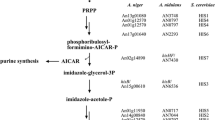Summary
One histidine-requiring clone (PO3) of Hyoscyamus muticus was isolated by testing 375 surviving colonies in an experiment in which 5-bromodeoxyuridine (BUdR) was applied to cell cultures derived from N-methyl-N'-nitro-nitrosoguandine (MNNG) treated haploid leaf protoplasts. In subsequent experiments inconsistent effects of BUdr on cell growth were observed and no further auxotrophs were obtained. Growth of PO3 was shown to be proportional to histidine concentrations up to 0.5 mM and two presumptive histidine precursors, histidinol phosphate and histidinol, also supported growth. A preliminary analysis of PO3 by somatic hybridization using two other auxotrophic clones of H. muticus indicated that the histidine auxotrophy of PO3 is a recessive trait. Further, as PO3 does not complement to wildtype with another His- line, VA5, these two His- lines may have the same biochemical lesion. Spontaneous protrophic revertants were present at a frequency of 3×10-7 per viable cell and this frequency was increased ca. 60 fold by MNNG treatment. Four tested revertants grew equally well in the presence or absence of histidine.
Similar content being viewed by others
References
Ashton NW, Cove DJ (1977) The isolation and preliminary characterisation of auxotrophic and analogue resistant mutants of the moss, Physcomitrella patens. Mol Gen Genet 154:87–95
Beadle GW, Tatum EL (1945) Neurospora. II. Methods of producting and detecting mutations concerned with nutritional requirements. Am J Bot 32:678–686
Gavazzi G, Nava-Racchi M, Tonelli C (1975) A mutation causing proline requirement in Zea mays. Theor Appl Genet 46:339–345
Gebhardt C, Shimamoto K, Lázár G, Schnebli V, King PJ (1982) Isolation of biochemical mutants using haploid mesophyll protoplasts of Hyoscyamus muticus III. General characterisation of His- and Trp- auxotrophs. Planta (submitted).
Gebhardt C, Schnebli V, King PJ (1981) Isolation of biochemical mutants using haploid mesophyll protoplasts of Hyoscyamus muticus II. Auxotrophic and temperature-sensitive clones. Planta 153:81–89
King J, Horsch RB, Savage AD (1980) Partial characterisation of two stable auxotrophic cell strains of Datura innoxia Mill. Planta 149:480–484
King PJ, Cox BJ, Fowler MW, Street HE (1974) Metabolic events in synchronized cell cultures of Acer pseudoplatanus L. Planta 117:109–122
Langridge J, Brock RO (1960) A thiamine-requiring mutantant of tomato. Aust J Biol Sci 14:66–69
Miflin BJ (1980) Histidine biosynthesis. In: The biochemistry of plants, vol 5. Academic Press, London, pp 533–539
Müller AJ, Grafe R (1978) Isolation and characterisation of cell lines of Nicotiana tabacum lacking nitrate reductase. Mol Gen Genet 161:67–76
Nelson OE (1968) The waxy locus in maize. II. The location of the controlling element alleles. Genetics 60:507–524
Potrykus I, Harms CT, Lörz H (1979) Callus formation from culture protoplasts of corn (Zea mays L.) Theor Appl Genet 54:207–214
Redéi GP (1975) Induction of auxotrophic mutations in plants. In: Ledoux L (ed) Genetic manipulations with plant materials. Plenum Press, New York, pp 329–350
Schieder O (1976) The spectrum of auxotrophic mutants from the liverwort Sphaerocarpus donnellii Aust. Mol Gen Genet 144:63–66
Shillito RD, Street HE, Schilperoort RA (1981) Model system studies of the use of 5-bromo-2′-deoxyuridine for selection of deficient mutants in plant cell suspension and protoplast cultures. Mutat Res 81:165–175
Sidorov V, Menczel L, Maliga P (1981) Isoleucine-requiring Nicotiana plant deficient in threonine deaminase. Nature 294:87–88
Strauss A, Frischknecht A, King PJ (1978) Selective killing of dividing plant cells in culture using nucleoside analogs. Experientia 34:958
Strauss A, King PJ (1981) Analysis of plating technique for viability and drug-sensitivity determinations using Rosa cells. Physiol Plant 51:123–129
Strauss A, Bucher F, King PJ (1981) Isolation of biochemical mutants using haploid mesophyll protoplasts of Hyoscyamus muticus. I.A NO −3 non-utilizing clone. Planta 153:75–80
Zryd J-P (1976) 5-bromodeoxyuridine as an agent in the selection of sycamore cell cultures. Plant Sci Lett 6:157–161
Author information
Authors and Affiliations
Additional information
Communicated by G. Melchers
Rights and permissions
About this article
Cite this article
Shimamoto, K., King, P.J. Isolation of a histidine auxotroph of Hyoscyamus muticus during attempts to apply BUdR enrichment. Molec Gen Genet 189, 69–72 (1983). https://doi.org/10.1007/BF00326056
Received:
Issue Date:
DOI: https://doi.org/10.1007/BF00326056




